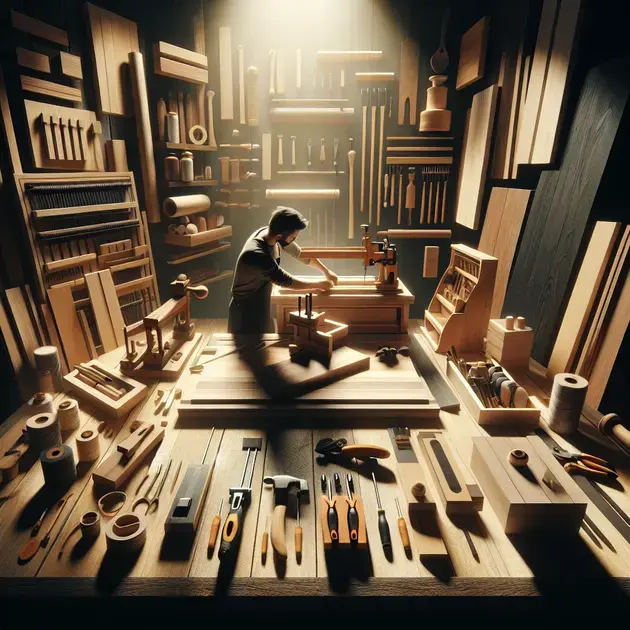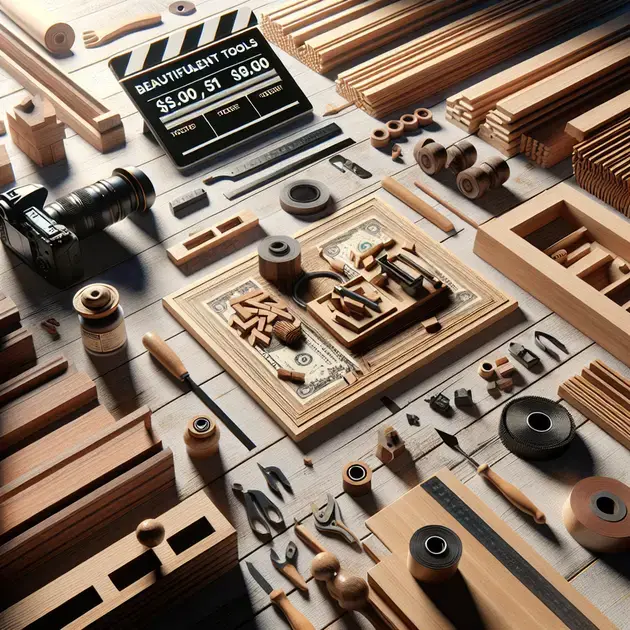Woodworking has been a beloved craft for centuries, with artisans honing their skills to create beautiful and functional pieces. Whether you’re a beginner or an experienced woodworker, mastering the art of woodworking requires dedication and the right knowledge. By following these essential tips, you can elevate your woodworking skills and create stunning projects with ease.
One important aspect of mastering woodworking is understanding the different types of wood and their characteristics. From hardwoods like oak and maple to softwoods like pine and cedar, each type of wood has unique features that impact its appearance and durability. By selecting the right wood for your project and learning how to work with it effectively, you can enhance the quality of your creations and achieve professional results.

Understanding the Different Types of Wood for Your Projects
When starting a woodworking project, it’s essential to understand the different types of wood available and their characteristics to choose the most suitable one. Websites like Wood Database offer extensive information on various wood species, including hardness, color, and grain patterns. By familiarizing yourself with these details, you can make informed decisions based on the project requirements.
One crucial aspect to consider is the distinction between hardwoods and softwoods. Hardwoods, such as oak and maple, come from deciduous trees and are known for their durability and strength. Softwoods, like pine and cedar, are sourced from coniferous trees and are generally more affordable and easier to work with. Understanding these categories will help you select the right wood for your specific project.
Another factor to evaluate is the moisture content of the wood. Excessive moisture can lead to warping or cracking in your final piece. Using a moisture meter, like the one from General Tools & Instruments, can help you determine the moisture levels in different wood types and ensure they are suitable for your project.
Additionally, knowing the specific uses for each type of wood is crucial. For instance, cherry and mahogany are popular choices for furniture making due to their rich tones and elegant appearance, while cedar is often preferred for outdoor projects because of its natural resistance to decay and insects. Researching the intended use of the wood will guide you in selecting the most appropriate option.
Lastly, consider the sustainability and environmental impact of the wood you choose. Websites like Forest Stewardship Council (FSC) provide certification for responsibly sourced wood, ensuring that your project aligns with eco-friendly practices. By being aware of these factors, you can create not only beautiful but also environmentally conscious woodworking projects.
Mastering the Art of Working with Hardwoods and Softwoods
Working with hardwoods and softwoods requires different techniques and considerations to achieve optimal results in your woodworking projects. Begin by selecting the appropriate tools for each type of wood. Hardwoods, with their higher density, may require sharper blades and more robust equipment to cut and shape effectively. Softwoods, on the other hand, can be worked with standard woodworking tools due to their softer composition.
Experimenting with various cutting and joinery methods is essential when mastering the art of working with different wood types. Websites like Popular Woodworking offer detailed tutorials on techniques such as dovetail joints for hardwoods and pocket hole joinery for softwoods. By practicing these methods, you can enhance your skills and create seamless connections in your projects.
Understanding the grain direction and pattern of hardwoods and softwoods is key to achieving a professional finish. Grain direction affects how wood expands and contracts, impacting the stability of your piece over time. Resources like Wood Magazine provide guidance on grain orientation and its influence on various woodworking processes, ensuring that you work in harmony with the wood’s natural characteristics.
Applying the right finish to hardwoods and softwoods is essential for showcasing their unique beauty and protecting the wood from environmental factors. Websites like Finishing.com offer recommendations on suitable finishes for different wood species, whether it’s an oil-based varnish for hardwood furniture or a water-based sealant for softwood outdoor projects. By following these guidelines, you can preserve the natural characteristics of the wood while enhancing its appearance.
Mastering the art of working with hardwoods and softwoods is a continuous learning process that requires practice, patience, and a deep understanding of each wood type’s properties. By honing your skills and techniques, you can elevate your woodworking projects to a professional level and create stunning pieces that stand the test of time.
Enhancing Your Woodworking Skills with Effective Wood Selection
Effective wood selection is a vital aspect of improving your woodworking skills and achieving successful project outcomes. One key step in this process is identifying the specific requirements of your project. Whether you’re building furniture, cabinets, or decorative items, understanding the functionality and design aspects will help you choose the most appropriate wood species.
Utilizing online resources like Woodworkers Source can provide valuable insights into the best wood options for different projects. These platforms offer detailed descriptions of various wood characteristics, allowing you to select wood that aligns with your aesthetic preferences and functional needs. By leveraging this information, you can enhance the quality of your woodworking creations.
Exploring the versatility of different wood species is essential for expanding your woodworking skills. Experiment with combining hardwoods and softwoods in a single project to create contrasting visual elements or structural reinforcements. Websites like Woodworkers Guild of America offer tutorials on incorporating diverse wood types in your projects, enabling you to broaden your skill set and creativity.
Understanding the importance of wood grain orientation and selection is crucial for achieving desired aesthetics in your projects. Grain patterns can significantly impact the visual appeal of your woodworking pieces, providing depth and character to the finished product. Websites like Woodcraft offer guidance on matching wood grains for cohesive designs, helping you enhance the overall appearance of your creations.
Enhancing your woodworking skills with effective wood selection involves continuous learning and experimentation. By staying informed about different wood types, exploring new techniques, and pushing the boundaries of your creativity, you can elevate your craftsmanship and create bespoke pieces that reflect your passion for woodworking.

**Maximizing Your Woodworking Budget Without Sacrificing Quality**
Setting a Realistic Budget
When it comes to woodworking projects, it’s essential to establish a realistic budget from the start. Consider the cost of materials, tools, and any additional expenses that may arise during the project. By setting a clear budget, you can determine where to allocate your funds and avoid overspending.
Step by Step:
1. Research the cost of materials and tools needed for your project.
2. Create a budget spreadsheet detailing all expenses.
3. Identify areas where you can potentially save money without compromising on quality.
4. Stick to your budget throughout the project to ensure financial discipline.
5. Reassess your budget if unexpected costs arise to stay on track.
Utilizing Cost-Effective Materials
One way to maximize your woodworking budget is by choosing cost-effective materials without sacrificing quality. Explore different wood options, such as reclaimed or sustainable sources, to reduce expenses while still achieving a beautiful end result. Additionally, consider using leftovers from previous projects or repurposing wood to minimize waste and save money.
Step by Step:
1. Research affordable wood options that align with your project requirements.
2. Purchase materials in bulk or look for discounts to lower costs.
3. Utilize scraps and leftovers creatively for smaller components or embellishments.
4. Experiment with alternative materials like plywood or composite wood for budget-friendly solutions.
5. Compare prices from different suppliers to find the best deals on quality materials.
Optimizing Tool Efficiency
Another key element in woodworking budget management is maximizing the efficiency of your tools. Ensure that your equipment is well-maintained to prevent costly repairs or replacements. Additionally, consider investing in multipurpose tools that can perform various functions, saving both money and space in your workshop.
Step by Step:
1. Regularly clean and lubricate your tools to prolong their lifespan.
2. Sharpen blades and replace worn-out parts to maintain optimal performance.
3. Explore the functionality of versatile tools that can handle multiple tasks.
4. Rent or borrow specialized equipment for one-time projects to avoid unnecessary expenses.
5. Prioritize quality over quantity when acquiring new tools to ensure long-term cost-effectiveness.
This approach to maximizing your woodworking budget without sacrificing quality allows you to create impressive projects while staying within your financial constraints. By carefully planning your expenses, selecting the right materials, and optimizing tool efficiency, you can craft affordable masterpieces that showcase your woodworking skills without breaking the bank.
**conclusão**
Maximizing your woodworking budget without sacrificing quality is a strategic process that involves setting a realistic budget, utilizing cost-effective materials, and optimizing tool efficiency. By following these steps diligently, woodworkers can achieve exceptional results while managing costs effectively.
Planning Your Budget
Beginning with a detailed budget plan is crucial for the success of any woodworking project. Researching material and tool costs, creating a comprehensive budget spreadsheet, and identifying areas for potential savings are key steps to fostering financial discipline throughout the project. By adhering to the budget and reassessing it as needed, woodworkers can avoid overspending and stay on track.
Choosing the Right Materials
Exploring cost-effective material options such as reclaimed or sustainable wood sources allows woodworkers to reduce expenses without compromising on quality. Leveraging leftovers from previous projects and creatively repurposing wood not only minimizes waste but also contributes to significant cost savings. By researching affordable wood choices, making bulk purchases, and comparing prices from various suppliers, woodworkers can find the best deals on quality materials.
Enhancing Tool Efficiency
Maintaining and optimizing tool efficiency is essential for maximizing the longevity and performance of woodworking equipment. Regular cleaning, lubrication, and blade sharpening help prolong tool lifespan and prevent costly repairs or replacements. Investing in multipurpose tools that can handle a variety of tasks and prioritizing quality over quantity when acquiring new tools ensure long-term cost-effectiveness in woodworking endeavors.
This holistic approach to budget management in woodworking empowers craftsmen to create remarkable projects within their financial constraints. By carefully planning expenses, selecting appropriate materials, and optimizing tool functionality, woodworkers can produce stunning pieces that showcase their skills while keeping costs in check.